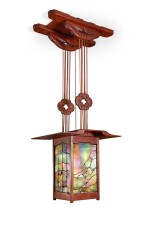
Greene & Greene
Monumental Lantern from the Entry of the Robert R. Blacker House, Pasadena, California
Auction Closed
April 20, 12:24 AM GMT
Estimate
400,000 - 600,000 USD
Lot Details
Description
Greene & Greene
Monumental Lantern from the Entry of the Robert R. Blacker House, Pasadena, California
Executed circa 1908.
executed in the workshop of Peter Hall, Pasadena, California
iridized and opalescent glass, mahogany and ebony with abalone, copper, fruitwood and silver inlays, leather straps
61½ in. (156.2 cm.) drop
lantern: 23 x 24½ x 21 in. (58.4 x 62.2 x 53.3 cm.)
Robert Roe and Nellie Celeste Canfield Blacker, Pasadena, California, 1908-1944
Mr. and Mrs. Clarence Otto Bockelman, by acquisition of the house and its contents, late 1940s
Max and Marjorie Hill, by acquisition of the house and its contents, circa 1950
Private Collection
Peter Osterlund and Amy Brooke Baker, Santa Monica, California
Wolf Family Collection No. 1155 (acquired from the above on November 30, 1998)
Randell L. Makinson, Greene & Greene: Furniture and Related Designs, Santa Barbara and Salt Lake City, 1979, p. 66 (for a photograph of the model in situ)
Randell L. Makinson, Greene & Greene, Layton, Utah, 1998, p. 99 (for a photograph of the model in situ)
Burce Smith and Alexander Vertikoff, Greene & Greene Masterworks, San Francisco, 1998, pp. 31 and 34 (for a photograph of the model in situ)
Edward R. Bosley, Greene & Greene, London, 2000, p. 108 (for a photograph of the model in situ)
Randell L. Makinson, Thomas A. Heinz and Brad Pitt, Greene & Greene: The Blacker House, Salt Lake City, 2000, pp. 54, 64 and 102 (for photographs of the model in situ)
Marvin Rand, Greene & Greene, Layton, Utah, 2005, p. 151 (for photographs of the model in situ)
Edward R. Bosley and Anne E. Mallek, eds., A New and Native Beauty: The Art and Craft of Greene & Greene, London, 2008, p. 2
This monumental lantern from the celebrated Robert R. Blacker House is one of Greene & Greene’s quintessential masterpieces. Considered the most important residential architects working in Southern California in the early twentieth century, Greene & Greene brought to the landscape a remarkable oeuvre of buildings employing novel construction techniques and unusual materials. Built for retired lumber baron Robert Roe Blacker and his wife Nellie Canfield on over five acres in Pasadena, the Blacker House was the largest and most elaborate of their designs, further distinguished by its masterful system of exterior and interior lighting.
The present example is one of only two interior lanterns of this scale and complexity, and as such was given prime position in the main entry of the house. Suspended from delicate leather straps, the mahogany frame echoes the Japanese-inspired architecture of the house itself with its dramatic silhouette, overhanging canopy, and elegant proportions. Japanese design inspired much of the brothers’ work following their visit to the St. Louis World’s Fair in 1904 where they experienced Japanese buildings, gardens, and decorative arts. The experience matured their architectural style, culminating in the Blacker House. At the Blacker House, the inspiration was first visible in the gardens, then in the expansive, pagoda-like roofs of the house, its wings, and the angled porte-cochere. The interior woodwork, with multiple complex joints held together with complicated iron straps, recalls the joinery of Japanese buildings and furniture. The woodworker Peter Hall (1867-1939) fashioned the mahogany frames of this lantern in the design of a Japanese temple lantern, suspended from the beams from leather cords threaded through partial tsuba (“sword guard”) shapes in wood. The handsomely crafted woodwork is further accented with small ebony pegs, a signature of the architects.
The warm wood encases four beautifully iridized glass panels, two of which depict floral vines meandering along a trellis and two of which depict stylized birds in flight against a sunset sky. Birds in flight were a favorite subjects of the brothers, and had appeared in a number of their earlier houses including the James A. Culbertson House (1902), the Jennie A. Reeve House (1903) and the Adelaide Tichenor House (1904-1905). In the case of the present lantern, the birds’ wings are cut from white glass which pops brilliantly against the iridized amber glass composing the sky background. The panel is given additional dimensionality through the use of copper foil, which imitates the gentle passage of clouds. These motifs are further articulated in subtle metal inlays within the wood, visually integrating the variety of materials. These details make the lantern an extraordinary synthesis of leaded glass and woodwork, exemplifying the architects’ unique vision and masterful craftsmanship.
You May Also Like






